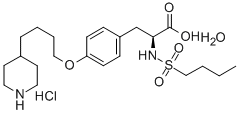SAFETY INFORMATION
| Signal word | Warning |
|---|---|
| Pictogram(s) |
 Exclamation Mark Irritant GHS07 |
| GHS Hazard Statements |
H302:Acute toxicity,oral H315:Skin corrosion/irritation H319:Serious eye damage/eye irritation H335:Specific target organ toxicity, single exposure;Respiratory tract irritation |
| Precautionary Statement Codes |
P261:Avoid breathing dust/fume/gas/mist/vapours/spray. P305+P351+P338:IF IN EYES: Rinse cautiously with water for several minutes. Remove contact lenses, if present and easy to do. Continuerinsing. |
COMPUTED DESCRIPTORS
| Molecular Weight | 477.1 g/mol |
|---|---|
| Hydrogen Bond Donor Count | 4 |
| Hydrogen Bond Acceptor Count | 7 |
| Rotatable Bond Count | 14 |
| Exact Mass | 476.2111712 g/mol |
| Monoisotopic Mass | 476.2111712 g/mol |
| Topological Polar Surface Area | 113 Ų |
| Heavy Atom Count | 31 |
| Formal Charge | 0 |
| Complexity | 579 |
| Isotope Atom Count | 0 |
| Defined Atom Stereocenter Count | 1 |
| Undefined Atom Stereocenter Count | 0 |
| Defined Bond Stereocenter Count | 0 |
| Undefined Bond Stereocenter Count | 0 |
| Covalently-Bonded Unit Count | 2 |
| Compound Is Canonicalized | Yes |
PRODUCT INTRODUCTION
description
Tirofiban Hydrochloride is the hydrochloride salt form of tirofiban, a non-peptide tyrosine derivative with anticoagulant property. Tirofiban antagonizes fibrinogen binding to the platelet cell surface receptor, glycoprotein (GP) IIb/IIIA complex, one of the two purinergic receptors activated by ADP. The antagonism prevents adenylyl cyclase activation, which mediated via GP IIb/IIIa receptor complex, and results in decreased levels of cAMP and thereby interferes with platelet membrane function and subsequent platelet-platelet interaction, release of platelet granule constituents and prolongation of bleeding time.
